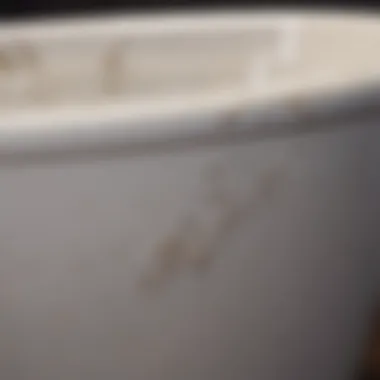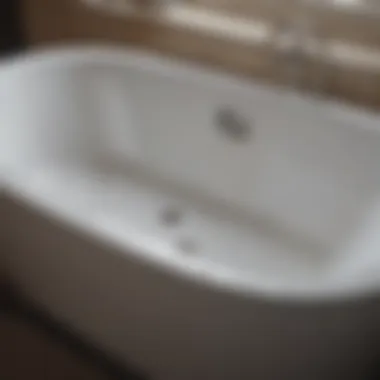Ultimate Porcelain Tub Repair Kit Guide


Overview of Topic
In the realm of home improvement, maintaining the integrity of your fixtures is paramount. Porcelain bathtubs, cherished for their aesthetic appeal and durability, can often suffer from wear and tear over time. This necessitates understanding the use of porcelain tub repair kits, which serve as essential tools for homeowners. A porcelain tub repair kit allows individuals to address superficial damage, thereby reducing the need for costly replacements.
The significance of porcelain tub repair kits lies in their ability to restore not just the appearance but also the functionality of the tub. These kits cater to common challenges faced by homeowners, such as chips, scratches, and discoloration. Properly utilizing these kits can prolong the lifespan of a tub and enhance overall bathroom ambiance.
Common Challenges and Solutions
Homeowners frequently encounter various issues that compromise the beauty and utility of their porcelain tubs. Here are some of the most common challenges:
- Chips and Cracks: A sharp object can cause unsightly chips, ruining the tub's finish.
- Stains and Discoloration: Harsh cleaning products or untreated spills can lead to stains that are difficult to remove.
- Rust and Corrosion: Between the porcelain surface and underlying metal, moisture can create rust over time.
To address these challenges, homeowners can implement a few solutions:
- Timely Repair: Immediately using a repair kit can prevent further damage. The kits typically contain an epoxy for chips or cracks, which provides good adhesion and a durable finish.
- Proper Cleaning Products: Opting for mild detergents and avoiding harsh chemicals can minimize discoloration.
- Routine Maintenance: Regular checks for any emerging issues can help in catching problems early, making repairs more manageable.
Product Recommendations
In the market, several brands provide high-quality porcelain tub repair kits. Notable mentions include these:
- Rust-Oleum Porcelain Chip Repair Kit: This kit is favored for its effective adhesive and color matching, making touch-ups seamless.
- Homax Porcelain Tub Repair Kit: Known for its user-friendly application process and effective blend for various colors.
- Repair-It Pro Porcelain Repair Kit: This option is highlighted for its quick-dry formula and exceptional bonding properties.
Each of these products provides features that cater to the unique needs of porcelain surface restoration. Benefits include ease of use, quick application, and the effective return of tub appearance post-repair.
Step-by-Step Guides
Implementing tub repairs can be a straightforward process. To simplify follow these practical steps:
- Assess the Damage: Thoroughly examine the affected area to determine the extent of the damage.
- Gather Supplies: Ensure to have a repair kit, a clean cloth, protective gloves, and a small mixing tool ready.
- Prepare the Surface: Clean the area around the damage using a mild cleaner to remove any dirt or oils.
- Mix the Repair Compound: Follow the instructions provided with the repair kit to mix the compound adequately.
- Apply the Compound: Using an applicator tool, carefully apply the compound over the damaged area, ensuring an even layer.
- Allow to Cure: Let the repair dry as instructed, usually requiring several hours to fully set.
- Polish the Surface: Once dried, gently sand the repaired area for a smooth finish and polish it to match the surrounding porcelain.
Following these steps can effectively lead to successful DIY repairs, allowing homeowners to maintain their porcelain tubs in excellent condition.
Timely repairs can extend the life of your porcelain tub significantly, saving you from costly replacements.
Prolusion to Porcelain Tub Repair
Porcelain tubs are often considered a symbol of elegance and sophistication in bathrooms. Over time, however, they can become damaged. Even small issues can lead to bigger problems if not addressed. Repairing porcelain tubs is essential for several reasons, primarily financial savings and aesthetics.
Fixing these tubs can save homeowners from the significantly higher costs associated with full replacements. Besides, an intact and shiny tub enhances the overall visual appeal of the bathroom. Moreover, maintaining the tub helps prevent further deterioration, ensuring longevity and usability.
Importance of Repairing Porcelain Tubs
Repairing porcelain tubs is crucial for maintaining their value and function. A damaged tub could lead to leaks and water damage, causing more extensive problems in the surrounding areas. Furthermore, an unappealing tub can detract from the enjoyment of the bathroom. Homeowners often spend considerable time and resources creating a relaxing atmosphere, and a chipped or stained tub can disrupt that environment.
Addressing small repairs promptly can prevent more serious issues, which saves homeowners money in the long run. It's not just about aesthetics but about securing the integrity of the tub itself.
Types of Damage Commonly Found
Understanding the common types of damage can help homeowners be proactive about repairs. The three primary types of damage include chips and cracks, discoloration and stains, and surface damage. Each type presents unique challenges and requires specific repair techniques.
Chips and Cracks
Chips and cracks are frequent concerns for porcelain tubs. These defects not only affect appearance but can lead to further structural weaknesses. Fixing chips and cracks early can prevent water from seeping subtiles and causing expensive water damage. This type of damage is often the result of impacts or temperature changes. The key characteristic of chips and cracks is their potential to expand if left untreated. Addressing these issues immediately can be beneficial as it helps maintain the tub's integrity.


Discoloration and Stains
Discoloration and stains often develop over time due to mineral deposits and soap scum buildup. This kind of damage is more about visual appeal but can be frustrating for homeowners. Over time, stains can become permanent if not managed right away. The unique feature of discoloration is its adaptability to cleaning methods. Many homeowners can prevent this type of damage by establishing regular cleaning routines. However, for persistent stains, specialized products may be required, which can be beneficial if used correctly.
Surface Damage
Surface damage consists of minor abrasions, scratches, or dullness that can affect the tub's finish. This damage can occur from the use of harsh cleaning products or abrasive scrubbers. The key characteristic of surface damage is its ability to accumulate over time, leading to a worn look. It can contribute to a dull appearance, which may affect the overall experience. Fortunately, surface damage is often easier to repair than chips or cracks, making it a popular choice for DIY enthusiasts.
In summary, understanding these types of damage is essential for homeowners looking to maintain their porcelain tubs efficiently. Addressing these issues proactively can keep bathrooms looking pristine while extending the life of the tub.
Understanding Porcelain Tub Repair Kits
Understanding porcelain tub repair kits is essential for maintaining the aesthetics and functionality of your bathroom. These kits are designed to address the wear and tear that porcelain tubs experience over time. Whether it’s chips, cracks, or discoloration, a proper understanding of these kits allows homeowners to make informed decisions about repairs.
A porcelain tub repair kit typically consists of several components, each serving a specific purpose. Knowing what to look for in these kits can significantly extend the lifespan of a tub. This understanding not only saves money on costly replacements but also enhances the overall value of your home.
Components of a Repair Kit
Epoxy Resins
Epoxy resins are a fundamental part of most repair kits. They provide a strong adhesive that helps to bond damaged areas in a porcelain tub. One key characteristic of epoxy resins is their durability. They can withstand a lot of stress and are resistant to water, which is crucial for a bathroom environment. Epoxy resins are popular because they create a seamless finish that blends well with the original tub surface. However, one disadvantage is that they often require precise mixing and application, making some kits challenging for DIY beginners.
Touch-Up Paints
Touch-up paints are included in repair kits to address minor surface imperfections and discoloration. The unique feature of touch-up paints is their ability to closely match the color of the original porcelain finish. This characteristic helps restore the tub to its previous appearance. Touch-up paints are beneficial because they are easy to apply and can provide immediate visual improvement. However, a common drawback is that they may not adhere well in high-moisture areas if the surface is not prepared properly.
Application Tools
Application tools are essential for the effective use of repair kits. These tools may include brushes, spatulas, and sanding blocks, each designed to aid in the repair process. A key characteristic of these tools is their ergonomic design, allowing ease of manipulation while working on delicate repairs. The inclusion of application tools in repair kits is highly beneficial as they simplify the process, ensuring that even novice DIYers can achieve satisfactory results. On the downside, using inappropriate tools or failing to follow instructions may hinder the repair quality.
Types of Repair Kits Available
Complete Repair Kits
Complete repair kits offer everything needed for a comprehensive restoration. This type of kit usually includes epoxy resins, touch-up paints, and application tools, all tailored for a specific tub model. A significant advantage of complete repair kits is convenience; users have all necessary products in one package, simplifying the repair process. However, one downside is that they may contain components that are unnecessary for simpler repairs, leading to increased costs without added benefits.
Surface Repair Kits
Surface repair kits focus on minor surface issues like scratches and discoloration. They usually include touch-up paints and basic application tools. One key feature of surface repair kits is their cost-effectiveness; they provide a targeted solution without the need for extensive materials. However, they may not be suitable for more extensive damage, which can limit their applicability.
Professional Grade Kits
Professional grade kits are designed for more severe damage and are often used by contractors. These kits contain higher-quality materials that provide a more durable and long-lasting finish. A notable characteristic of professional grade kits is their advanced formulations. They can yield superior results when applied correctly. However, they may come with a higher price tag and require some experience for best application, making them less accessible for average homeowners.
Evaluating Repair Kits
Evaluating repair kits is a critical step in ensuring successful porcelain tub maintenance. Homeowners must be discerning about the products they choose, as not all kits are created equal. Factors such as quality of materials, ease of use, and longevity of results will significantly determine the effectiveness of the repair process. A careful evaluation can save time and money, fostering a more satisfying outcome.
Criteria for Selection
Quality of Materials
The quality of materials used in a repair kit strongly influences its overall performance. High-quality materials tend to deliver more durable and effective results. Epoxy resins and specific touch-up paints must withstand not just physical wear but also exposure to water and cleaning agents common in bathrooms. A key characteristic of solid materials is their resistance to yellowing and chipping over time. This feature is beneficial because it ensures repairs maintain their appearance long-term, enhancing the tub's aesthetic appeal. Conversely, lower-quality materials can lead to peeling or discoloration, diminishing both the look and functionality of the tub. Thus, selecting a repair kit made with high-quality materials is a crucial consideration.
Ease of Use


Another important criterion is the ease of use of a repair kit. Many house owners prefer kits that are user-friendly, especially if they plan to tackle the repairs themselves. Clear instructions and the simplicity of the application process make a kit more attractive. Notably, some kits come with pre-measured components, eliminating guesswork in mixing ratios. This ease of use can foster greater confidence in DIY repairs. However, an easy-to-use kit might not always equate to professional-level results. There may be limitations in the range of damages it can effectively address, steering some homeowners toward more complex options if they require extensive repairs.
Longevity of Results
The longevity of results from a repair kit is a significant aspect to evaluate during selection. Homeowners desire a solution that does not necessitate frequent touch-ups or repairs. Kits that promise a long-lasting finish are often considered more valuable. A high-quality repair should withstand daily use and not degrade significantly over time. However, it is important to note that products boasting exceptional longevity often require precise application techniques. If these techniques are not followed correctly, the results can fall short of expectations. Balancing ease of use with the potential for long-lasting outcomes is a challenge that requires careful consideration.
Product Reviews and Recommendations
When searching for the best porcelain tub repair kits, consulting product reviews and recommendations provides invaluable insight. First-hand experiences and assessments from other users can guide home owners towards the most reliable products. Platforms like Reddit or dedicated consumer forums can offer candid opinions.
"User reviews reveal real-world performance that's not found in product specs. Evaluating those can save time and money."
Look for kits that consistently receive high ratings for quality, ease of application, and durability. Some popular recommendations may include Rust-Oleum Porcelain Tub Repair Kit and Homax Tough as Tile Tub and Sink Repair Kit, which are often noted for their effectiveness.
In summary, evaluating the right repair kit requires consideration of material quality, user-friendliness, and the expected durability of results. Through careful analysis and research, homeowners can make informed decisions that will lead to a successful repair of their porcelain tubs.
Step-by-Step Application Guide
The section dedicated to the step-by-step application guide is crucial in ensuring a proper and lasting repair to porcelain tubs. Understanding each phase of the process not only fosters confidence in homeowners but also significantly increases the likelihood of a successful outcome. By following these steps carefully, one can minimize mistakes and enhance the durability of the repair materials used. Mastery of this guide leads to satisfaction, as it equips homeowners with the necessary skills to restore their tubs efficiently while avoiding the high costs of professional services.
Preparing the Tub Surface
Before any repair can be made, it is vital to prepare the tub's surface thoroughly. This step ensures that the repair materials adhere properly. Start by cleaning the area around the damage using a mild detergent or a specialized bathroom cleaner. Avoid harsh chemicals that could damage the surface further.
After cleaning, rinse with water and dry the area completely with a soft cloth. This step removes any residue, dirt, or moisture, which could hinder adhesives and paints from setting correctly. If the damage includes chips or cracks, gently sand the edges to create a smooth surface. This approach helps the repair material bond better and conceals the repair more effectively.
Mixing Repair Materials
Once the surface is ready, the next step involves mixing the repair materials accurately. Follow the manufacturer's instructions carefully, as different products may require specific mixing procedures. Generally, you will need to mix epoxy resins or other compounds with hardeners. Use a clean container and stir thoroughly to achieve a uniform consistency.
Any lumpiness or uneven mixing can compromise the final result, so take your time with this step. Consider wearing gloves to protect your hands from any potentially hazardous materials. Pay attention to the working time specified on the package; this is the period in which the mixture will remain workable.
Applying the Repair Mixture
Applying the repair mixture demands precision and steady hands. Use a spreading tool, such as a putty knife, to apply the repair compound evenly across the damaged area. Ensure that you are filling all cracks or voids, and do not worry if the mixture overflows a bit since you will smooth it out later.
It is essential to work quickly during this stage, as some materials may begin to set rapidly. Always aim for an even layer that extends slightly beyond the damaged area. This technique not only ensures better adhesion but also helps merge the repair with the original surface seamlessly.
Finishing Touches and Curing
After applying the mixture, smooth the surface with a clean tool to minimize imperfections. This may involve a sandpaper finish once the material has cured. Most products will indicate a curing time, which you must adhere to for optimal results. Let the repair sit undisturbed and ensure that the environment is suitable—avoid moisture and temperature extremes.
Once cured, inspect the area closely. If necessary, a second application may be required for deeper repairs. After finishing all the steps, clean any excess material surrounding the area before the curing is entirely complete. This attention to detail will leave a professional finish.
"Proper preparation is key to achieving a seamless repair that lasts. Ensure each step is followed meticulously for the best outcome."
By recognizing the significance of each phase in this application guide, homeowners can effectively restore the integrity of their porcelain tubs, resulting in improved aesthetics and functionality.
Maintenance Tips for Porcelain Tubs
Maintaining porcelain tubs is crucial for prolonging their lifespan and ensuring they remain aesthetically pleasing. Porcelain is a durable material, but it can be susceptible to damage from harsh cleaning products, neglect, and improper use. By implementing effective maintenance practices, homeowners can prevent problems like chips, cracks, and discoloration, which might require repairs or replacements. The following tips offer guidance on keeping your porcelain tub in optimal condition.
Regular Cleaning Practices
Regular cleaning is essential to preserve the shine and integrity of porcelain tubs. Here are some effective cleaning practices:


- Use mild cleaners: Opt for gentle, non-abrasive cleaners. Harsh chemicals can strip the finish or create micro-abrasions.
- Soft cloths or sponges: When cleaning, always use a soft cloth or sponge to avoid scratching the surface. Abrasive pads should be avoided.
- Frequency of cleaning: Establish a weekly cleaning routine. This can prevent buildup of soap scum and mineral deposits, which can lead to stains and discoloration.
- Rinsing: Always thoroughly rinse the tub after cleaning to remove any residue from cleaning products. This can help maintain the porcelain's surface finish.
"Routine maintenance not only keeps your tub looking like new but also saves money in the long run by preventing extensive repairs."
By sticking to these practices, homeowners can ensure that the beauty of their porcelain tub lasts longer.
Avoiding Common Pitfalls
While taking care of porcelain tubs, certain common mistakes should be avoided to prevent damage:
- Skipping Regular Maintenance: Neglecting regular cleaning can lead to buildup that becomes harder to remove over time.
- Using Wrong Tools: Avoid using steel wool, scrub brushes, or anything abrasive. These can scratch the surface, making the tub more susceptible to stains.
- Improper Drainage: Ensure that the tub drains properly. Standing water can create stains or promote mold growth.
- Exposure to Heavy Objects: Be cautious of heavy items that might fall onto the tub. Porcelain is strong, but it can chip or crack under enough force.
Being mindful of these pitfalls can help maintain the tub's condition and save on costly repairs. Regular check-ups and maintenance can lead to a beautiful and functioning porcelain tub that enhances the bathroom's appeal.
Professional Repair Services
Hiring professional repair services can be a vital consideration for homeowners facing significant damage to their porcelain tubs. While many repairs can be handled with DIY kits, certain situations necessitate expertise that only trained professionals can provide. These services ensure that repairs are executed correctly and with quality materials, thereby restoring the functionality and aesthetic appeal of the tub.
Among the primary benefits of opting for professional help includes the use of advanced techniques and specialized equipment. Professionals possess the skills required to tackle extensive damage, such as deep cracks or chips that extend beyond the surface layer. This expertise often results in a more durable and long-lasting repair compared to using consumer repair kits on their own. Additionally, professionals can often complete the job more quickly, avoiding the time-consuming processes involved in DIY repairs.
Another consideration when thinking about professional repair services is the warranty that typically accompanies such work. This can provide homeowners with peace of mind that should something go wrong after the repair, they are covered without incurring further costs.
Professional repair can transform a damaged porcelain tub into a feature of your bathroom again, increasing both enjoyment and property value.
When to Seek Professional Help
Homeowners should consider seeking professional assistance in various scenarios. If the damage is extensive, like deep, persistent cracks or complete surface loss, a professional has the tools and knowledge needed to ensure a successful outcome. Similarly, if the issue is a repeated one—for instance, you have attempted repairs multiple times without lasting results—it might signal a need for professional intervention.
In some cases, homeowners may notice issues that they cannot easily define. Unusual sounds when filling the tub or water leakage may point to deeper structural problems. In these instances, a professional can assess the situation correctly and make recommendations on repairing or replacing the tub.
Understanding Cost Factors
The costs associated with professional porcelain tub repair can vary widely depending on several factors. First, the type of damage plays a significant role. Minor chips may incur a lower cost, whereas extensive damage or multiple areas requiring repairs can lead to higher expenses.
Labor costs are another critical factor. If a professional repair service has a high reputation or specialized expertise, their fees may be more significant. Furthermore, the location can contribute to price variance. Urban areas may have higher labor rates due to increased cost of living.
Finally, the materials used in the repair work can impact the price. High-quality epoxy or durable paint will likely elevate the overall cost but will also increase the durability of the repair, providing better long-term value.
As a homeowner, it is prudent to gather several estimates and inquire about the methods used, materials employed, and warranty details provided before making a decision.
By assessing the cost factors and when to seek professional help, homeowners can make informed choices on maintaining and repairing their porcelain tubs.
Closure and Final Thoughts
The conclusion and final thoughts section serves a critical role in synthesizing the extensive information covered in the article. It not only helps to reinforce the importance of porcelain tub repair but also provides a coherent summary of key insights that can influence the reader's approach to maintaining their baths. Such a wrap-up ensures that readers depart with both a strong understanding and actionable knowledge.
Recap of Key Points
To encapsulate what has been discussed, several essential points stand out:
- Importance of Repair: Maintaining a porcelain tub is not merely about aesthetics; it enhances longevity and prevents more significant issues down the line.
- Understanding Kits: Knowledge of the components of repair kits such as epoxy resins, touch-up paints, and the tools is vital for successful application.
- Do-It-Yourself Approaches: The step-by-step application guide provides clarity for homeowners who choose a DIY approach, ensuring they can confidently tackle repairs.
- Professional Services: Sometimes, the damage may exceed what can be managed through kits alone, highlighting when it is beneficial to seek expert assistance.
- Future Trends: Awareness of innovations in repair materials and techniques can further enhance the effectiveness of future repairs.
This recap emphasizes the main elements that the article covered, reinforcing the reader's understanding of how to effectively manage porcelain tub care.
Future Trends in Porcelain Repair
The industry for porcelain repair is continually evolving. Emerging trends suggest several areas of focus:
- Eco-Friendly Materials: There is an increasing demand for eco-conscious products that minimize environmental impact, indicating a move towards sustainable repair solutions.
- Advanced Technology: Innovations in repair materials, such as self-leveling epoxies or even smart coatings, that can detect and seal small cracks automatically, are on the horizon.
- Customized Repair Kits: Future kits may also become more specialized, catering to specific brands and models of tubs, which could improve repair outcomes significantly.
- Education and Workshops: As awareness grows, local workshops for homeowners could become popular, providing hands-on training for effective repair techniques.
Staying informed about these trends can equip readers with the necessary tools and insights to improve their home maintenance strategies, leading to better care for porcelain tubs.







